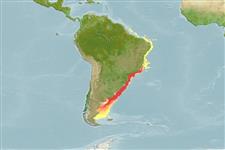Preferred temperature (Ref.
123201): 10.4 - 22.6, mean 14.8 °C (based on 300 cells).
Phylogenetic diversity index (Ref.
82804): PD
50 = 1.0000 [Uniqueness, from 0.5 = low to 2.0 = high].
Bayesian length-weight: a=0.00490 (0.00309 - 0.00776), b=3.02 (2.89 - 3.15), in cm total length, based on LWR estimates for this species & (Sub)family-body (Ref.
93245).
Trophic level (Ref.
69278): 3.6 ±0.0 se; based on diet studies.
Generation time: 5.2 ( na - na) years. Estimated as median ln(3)/K based on 1
growth studies.
Widerstandsfähigkeit (Ref.
120179): niedrig, Verdopplung der Population dauert 4,5 - 14 Jahre. (Assuming fecundity<100).
Fishing Vulnerability (Ref.
59153): Moderate to high vulnerability (54 of 100).
Nutrients (Ref.
124155): Calcium = 43 [7, 197] mg/100g; Iron = 0.911 [0.243, 2.649] mg/100g; Protein = 17.3 [14.6, 19.8] %; Omega3 = 0.522 [0.178, 1.883] g/100g; Selenium = 16.5 [4.9, 49.3] μg/100g; VitaminA = 16.8 [6.1, 46.1] μg/100g; Zinc = 0.769 [0.367, 1.401] mg/100g (wet weight);
